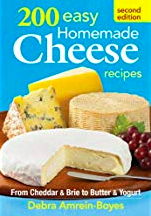How do you learn to make cheese?
Fraser and I often get asked about how we got into cheese making, and whether we already knew what we were doing before we decided to start our cheese business. Actually, we didn't! We had the idea of becoming cheesemakers first, and then set about learning how to do it.
Compared to making bread or jam, cheese is much harder to make at home. It can be done, and it is quite possible to make really good fresh cheese in a normal kitchen. Anything where you want to develop a rind or mature it for any length of time is rather trickier, though you can do it with some persistence. The key really is trial and error, repeating the process many, many times.
Our first port of call was google, and we came across an excellent blog on Andy Swincoe's Courtyard Dairy website: https://www.thecourtyarddairy.co.uk/blog/making-ageing-cheese/i-want-to-become-a-professional-cheese-maker-where-do-i-start/
After reading this, we ordered a basic home cheese making kit from Moorlands and had a go with supermarket milk at home; the first batch failed (it wouldn't set because, like most of what you get in a supermarket, the milk was homogenised) but our second batch resulted in something vaguely resembling a cheese:

It was edible but didn't taste of much, and we immediately realised how important it was to make cheese with excellent quality milk. We also realised this was just the start of a long process!
The next crucial step was to go on a proper cheese making course - Fraser and I both did courses with Paul Thomas at the excellent School of Artisan Food, which I can't recommend enough: https://www.schoolofartisanfood.org/categories/cheesemaking
Once we had done a course, we were in a much better position to understand what we were doing, and we invested in some more extensive basic cheese making kit which enabled us to make at home to a higher standard. The essentials were a basic pH meter, a small wine cooling fridge (so we could create the right climate to mature cheese), cheese moulds, starter cultures and some basic food grade plastic crates so we could process 10 or 20 litres of milk at a time, which our saucepans wouldn't hold. We still use these crates now when doing trial makes. The cheese making equipment was from goat nutrition (https://www.gnltd.co.uk/), the pH meter from CamLab (https://www.camlab.co.uk/myron-l-ultrapen-pt2-ph-temperature-tester-p27598.aspx) and the crates from plastor (https://www.plastor.co.uk/euro-stacking-containers-with-and-without-lids-folding-containers/prime-economy-range-euro-containers/). Our wine cooler was from argos, and we also got a hygrometer for measuring humidity in the maturing environment from amazon. We spent about £300 getting our kitchen set up for cheese making.
Using this kit, and with fresh raw goats milk from a local smallholder, we were able to start making and maturing goats cheese at home. There was a lot of trial and error, but making once a week or once a fortnight and keeping careful records of each make (times, pH and temperature, starter quantities etc) really helped us gain a much deeper understanding of how a cheese like this was made, what could go wrong (and right!), and how we could control it.
We bought a couple of books that were very helpful - the classic Fabrication of Farmstead Goat Cheeses is translated from French and decades old - a bit of a dry read, but really useful. We also bought Mastering Artisan Cheesemaking – Gianaclis Caldwell and 200 Easy Homemade Cheese Recipes by Debra Amrein-Boyes, which were useful stepping stones for ideas of different variables to try. Paul Thomas' Home-Made Cheese wasn't published then, but if I were starting out again now it would definitely be a book to have.
Visits to other cheesemakers were also really useful, and many were happy to show us around. The Specialist Cheesemakers Association map (http://www.specialistcheesemakers.co.uk/directory/map-of-sca-members.aspx?tbxLocation=&tbxPostcode=&tbxDistance=500&tbxCity=London&lstCategory=&lstCountry=234) was helpful in finding other cheesemakers local to us. One of these visits in fact led to me being offered some part time work by Rose at Nettlebed Creamery, so I was able to start getting experience of making cheese in a professional environment, which really helped us understand what we would need in our own premises.

Learning about food safety was also a really important step when we knew we wanted to go professional, and we both took Food Safety and HACCP qualifications, which are needed if you want to sell to the public or attend farmer's markets. I used the provider Kitchen Tonic, which I would really recommend: http://www.kitchentonic.com/
The time came when our kitchen was no longer good enough though, and at that point we needed to find more specifically appropriate for cheese making and maturing. We decided not to build our own place just yet, as we were still developing our process and didn't want to spend lots of money before we were certain what we needed the place to be like. We were lucky to be able to rent a couple of rooms at Nettlebed Creamery - a superb opportunity as it was purpose built for cheese making. We also looked into converting our garage, converting a portacabin and renting an industrial unit, however we needed to be within striking distance of the farm where the goats are, so this was the best option for us all round.
The trial and error continued though! There were 3 months between us starting to rent our new rooms at Nettlebed and getting to the point of having finalised our recipe to the point we could draw up a HACCP and apply for approval from the Environmental Health Department. 18 months after our first ever cheese make, we got approval through, and two months later, won our first awards at the Artisan Cheese Awards.





























